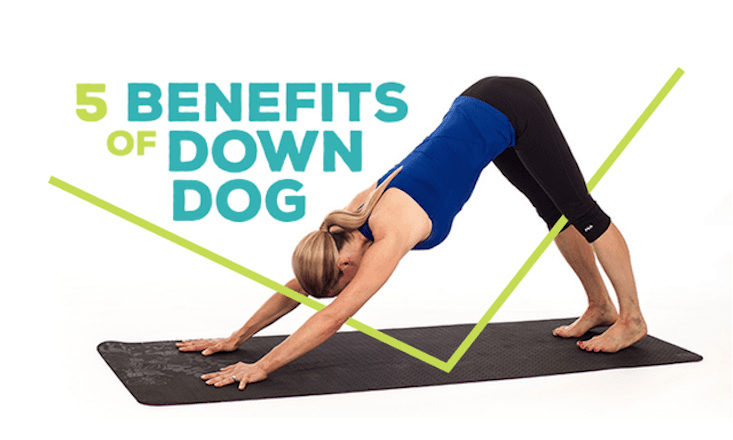Downward Facing Dog Pose is one you will definitely want to learn as a beginner. I like to say a Downward Dog a day keeps the doctor away.
The pose has so many benefits. Downward Dog can work out any kink in the body and bring blood flow to the brain. It also strengthens, lengthens, and energizes every one of your muscles. It’s important to learn how to do Down Dog correctly so you can truly reap all of the rewards of the pose.
Seasoned yogis say that Downward Dog is a resting pose, which can seem impossible when you first begin practicing! If you want to work on your Downward Facing Dog or any other pose, you could give this free 30 Day Yoga Challenge a try! The guided practices will help you settle into poses, so they come more naturally.
Below you’ll find the many benefits of the pose, and above is a picture to help you check your alignment.
1. Strengthens the Arms and Shoulders
When you’re in Down Dog, you want to externally rotate the upper arms to create space around the head and neck. Try and rotate your inner elbows towards each other. Don’t lock out your elbows, but squeeze the triceps around the arm bones. Press your hands firmly into the mat, especially in the thumb and forefinger region.
Down Dog is also good for the wrists and can help prevent carpal tunnel syndrome.
2. Tones the Core and Waist
As you hold Down Dog, you’re actively engaging your core region. Focus on drawing your lower abdominals in and slightly upwards while drawing your front bottom ribs towards each other and lengthening through the sides of your waist.
Downward Dog is a great way to strengthen and tone the abdominals. Make sure to also engage your pelvic floor muscles by drawing a line up from the base of your spine which lengthens through the crown of the head.
3. Lengthens the Hamstrings and Calves
One of my favorite benefits of Down Dog is the stretch in the back of the body, mainly in the hamstrings and the calves. Even if you’re very stiff and tight, you can keep your knees bent and you will still feel the stretch in the back of the thighs.
You’ll also gain strength in the legs while you lengthen them. Engage your quadriceps actively to open the hamstrings. Imagine your heels lengthening to the floor as you lift your hips towards the ceiling.
4. Brings Blood Flow to the Brain
Downward Dog is a very basic inversion and great for beginners since most other inversions are somewhat challenging. When you have your head below your heart, you will bring blood flow to the brain.
This position is great for lifting your energy and helping you focus. As you let your head hang long, you will also release any tension in your neck. Practice this in the morning to wake up or at any point of the day to get a breath of fresh air and recharge your batteries.
5. Stretches the Spine and Strengthens the Back
When you’re practicing Down Dog, it’s as if you’re your own personal rack, stretching the spine apart from head to toes. It’s an incredible feeling to get length in the back of the body. This pose is therapeutic for back care and can help heal the body on so many levels.
By lengthening and stretching the spine, you bring more oxygen in to the body. You will feel a stronger, longer backbone and spine as well as more strength in the entire back body as you practice this pose.
I highly recommend beginners and all yoga practitioners to “walk” their dog daily. Downward Dog is a pose that makes everyone longer, taller, stronger, happier, more flexible, and energized.
Namaste!


